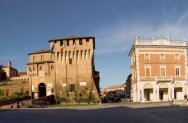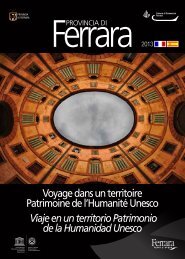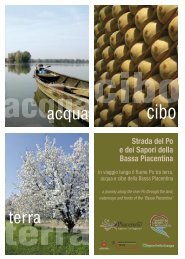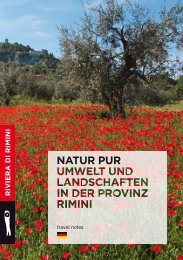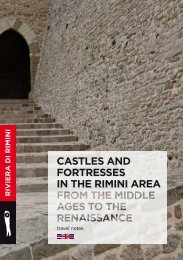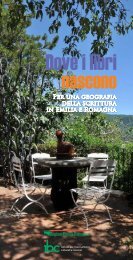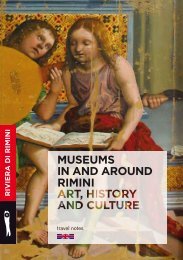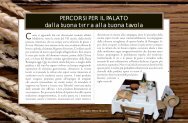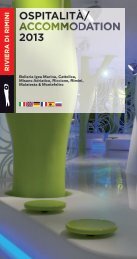Terme di Cervia - Emilia Romagna Turismo
Terme di Cervia - Emilia Romagna Turismo
Terme di Cervia - Emilia Romagna Turismo
- No tags were found...
You also want an ePaper? Increase the reach of your titles
YUMPU automatically turns print PDFs into web optimized ePapers that Google loves.
| Saline <strong>di</strong> <strong>Cervia</strong> | <strong>Cervia</strong> saltpans |La raccolta del sale nelleSaline <strong>di</strong> <strong>Cervia</strong>.The salt harvesting in<strong>Cervia</strong> saltpans.03.Saline CERVIA SALTPANS<strong>di</strong> <strong>Cervia</strong>Le saline <strong>di</strong> <strong>Cervia</strong>, <strong>di</strong> antica origineetrusca, sono il giacimento dalquale l’ “oro bianco” viene ancora estrattosia con il metodo artigianale, nella piùantica salina Camillone, sia con il metodoindustriale, nella salina a raccolta unica.Fanno parte del Parco della Salina <strong>di</strong> <strong>Cervia</strong>che a sua volta è parte del Parco del Deltadel Po. Da esse si estrae il sale integrale,composto per il 98% <strong>di</strong> cloruro <strong>di</strong> so<strong>di</strong>opuro che non subisce alcuna lavorazione,ma solo il lavaggio e la centrifugazione conacqua madre, prima <strong>di</strong> essereimpacchettato e messo in commercio. È unsale dolce anche grazie alla mancanza <strong>di</strong>altri sali potassici esistenti nell’acqua delmare e per questa sua caratteristica èottimo in cucina poiché non copre i saporied è con<strong>di</strong>mento bastevole per il pesce chenon ha bisogno <strong>di</strong> salse ricercate.Anticamente, il sale <strong>di</strong> <strong>Cervia</strong> venivainviato alla mensa pontificia e tuttora simantiene questa tra<strong>di</strong>zione con laconsegna annuale al Santo Padre del “ saledei Papi”.Nello spaccio del Parco della Salina enei migliori negozi del centro citta<strong>di</strong>no èpossibile acquistare sia il prodotto <strong>di</strong> base,il sale grosso, sia i prodotti derivati, comei sali fini speziati suggeriti per i <strong>di</strong>versi tipi<strong>di</strong> cibo. Vi è poi una piccola produzione<strong>di</strong> “Salfiore <strong>di</strong> <strong>Cervia</strong>” ricavato da quellostrato che si forma in minime quantitàin alcune fasi della produzione che vieneraccolto solo a mano ed è immesso sulmercato invasetti sulla cui etichetta sonoin<strong>di</strong>cati l’anno <strong>di</strong> raccolta e <strong>di</strong> produzioneeil numero <strong>di</strong> vasetto rispetto a tutti quelliconfezionati. Per comprendere la millenaria“civiltà dell’oro bianco” si consiglia <strong>di</strong>visitare il Museo del Sale Musa, allestitonel seicentesco Magazzino del Sale Torre,in pieno centro storico. Qui i volti e lestorie dei salinari introducono un percorsoguidato fatto <strong>di</strong> au<strong>di</strong>ovisivi, pannelli,12.plastici e antichi strumenti <strong>di</strong> lavoro fracui la burchiella, la barca in metallo afondo piatto capace <strong>di</strong> contenere fino a 80quintali <strong>di</strong> sale. Nella salina Camillone,invece, il Gruppo Civiltà Salinara proponel’esperienza <strong>di</strong> “salinaro per un giorno” persperimentare l’attività dell’estrazione delsale con l’antico metodo artigianale.Le saline erano costruite ingegnosamentea livello zero del mare, per consentireall’acqua <strong>di</strong> entrare con l’alta marea e <strong>di</strong>uscire con la bassa. Esse utilizzano energiegratuite e pulite, il calore solare e l’azionedel vento, e sfruttano il principio dei vasicomunicanti: il livello del fondo dellevasche è degradante in modo da ottenereil trasferimento dell’acqua da una vascaall’altra per caduta naturale.Un tempo, una volta raccolto, il sale venivatrasportato dalla salina ai magazzini (la<strong>di</strong>stanza variava da 1 a 5 km) lungo icanali <strong>di</strong> percorrenza. Questa operazioneprendeva il nome <strong>di</strong> “rimessa del sale”,ancor oggi ricordata nella tra<strong>di</strong>zionale festadel secondo fine settimana <strong>di</strong> settembre“Sapore <strong>di</strong> Sale”.Oggi le saline sono <strong>di</strong>mora <strong>di</strong> numerosespecie <strong>di</strong> volatili che vi ni<strong>di</strong>ficano e visostano durante le migrazioni annuali. Perosservarli è possibile prenotare percorsi apie<strong>di</strong> <strong>di</strong> birdwatching e itinerari in biciclettao in canoa presso il Centro Visite del Parco.<strong>Cervia</strong> saltpans, of Etruscan origins,are a salt deposit where the “whitegold” is still collected by mean of thetra<strong>di</strong>tional han<strong>di</strong>craft method - like in theolder Camillone Saltpan – as well as thesingle-accumulation industrial method.They are part of <strong>Cervia</strong> Salpans Park, whichis included in the Po Delta Park. Theyproduce rough salt, consisting of pureso<strong>di</strong>um chloride at a percentage of 98. Thissalt does not undergo any process exceptwashing and centrifuging in salt liquor,before being packaged and merchan<strong>di</strong>sed.This salt tastes “sweet” due to the lack ofother types of seawater potassium salt init, and for this reason it is excellent forcooking, as it does not cover the otherflavours. In particular, it is an idealseasoning for fish, that does not requireany sophisticated sauce. In past times,<strong>Cervia</strong>’s salt was sent for the Pope’s <strong>di</strong>ning.Nowadays this tra<strong>di</strong>tion is still alive thanksto the yearly gift of the “salt of the Popes”to the Holy Father.In the shops of the Saltpans Park and in theinner city, it is possible to purchase bothrough salt and derived products, such asseveral types of refined and spiced salt thatfit <strong>di</strong>fferent <strong>di</strong>shes. In ad<strong>di</strong>tion, there is asmall production of “Salfiore <strong>di</strong> <strong>Cervia</strong>”, asort of first-choice product that is formed ina thin layer during some of the productionsteps and is collected manually to be thenmerchan<strong>di</strong>sed in small jars, numbered andlabelled with the exact in<strong>di</strong>cation of thecollection year and the overall number ofjars. Visitors wishing to get to know themillennial history of the so-called “whitegold civilization” should visit MUSA – theMuseum of Salt - hosted in the 17thcentury “Torre” salt storehouse, right in thecity centre. Here, you are accompanied bythe salt workers pictures and stories alonga guided route with au<strong>di</strong>ovisuals, boards,renderings and ancient working tools, suchas the “burchiella” – a flat-bottomed ironboat that could transport up to 80 quintalsof salt. Conversely, in the saltpan Camillonethe volunteers group of Salt WorkersCulture offers visitors the chance to be “asalt worker for one day”, experiencing theactivity of salt collection through the oldhan<strong>di</strong>work procedure.The saltpans were cleverly designed atzero sea level, which enables the waterto flow into their basins by high tide andflow out by low tide. They are still poweredby natural, clean energy sources, suchas sunlight and wind, also exploiting theprinciple of communicating vessels. In factthe bottom of the various basins is meantto slope, in order to let the water naturallyrun from one basin to another.In past times, the salt was transported,upon collection, from the saltpans to thesalt storehouses – 1 to 5 km away – alongcanals. This move was called “rimessa delsale”, an event that is still recalled by atra<strong>di</strong>tional festival called “Sapore <strong>di</strong> Sale” -a Taste of Salt” - taking place every secondweek end of September.<strong>Cervia</strong> saltpans host nowadays severalspecies of birds that nest there or stop overduring their yearly migrations. This wildlifecan be observed by booking a guidedbird-watching walk, bike ride or canoe tour,all organised by the Visitors Centre of thePo Delta Park.48015 CERVIA (RA) - Lungomare G. D’Annunzio (ang. V.le Roma, 85)0544 970442 - 335 375316 - 338 5262282www.resaleristorante.com - info@resaleristorante.com.13



